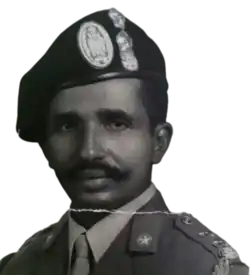Omar Haji Mohamed
Major General Omar Haji Mohamed Cumar Xaji Maxamed | |
|---|---|
 Colonel Masalle in 1973 | |
| Minister of Defence | |
| In office 1981–1982 | |
| Personal details | |
| Born | 1934 Beledweyne, Somalia |
| Died | November 2014 (aged 80) Mogadishu, Somalia |
| Nickname | Massale |
| Military service | |
| Allegiance | |
| Branch/service | Somali Army |
| Years of service | 1961–1991 |
| Rank | |
| Commands | Minister of Defence Deputy Commander in Chief of the Armed Forces Commander of 2nd Armoured Brigade |
| Battles/wars | Somali civil war
|
| Awards | Gold Medal for Bravery and Service[1] |
Omar Haji Mohamed 'Masalle' (Somali: Cumar Xaaji Masalle); (1934 – 2014). Born in Beledweyne from a Marehan family. He was a commander of the Somali military in the Hiiraan Region, in Central Somalia.[2] Before he joined the military, he was a language teacher. He also became a Somali Minister of Defence and health minister.
Biography
Masale was one of the commanding officers of the Ogaden War, and was ethnically related to the late Somali president Siad Barre. Masale was the second deputy to the joint chiefs of staff and the head of the 2nd armored division (formerly 2nd Brigade).[3]
Somali National Front
In 1991, after the collapse of the Somali Democratic Republic Omar lead the Somali National Front (SNF). Which stretched from the Gedo region of Somalia, to Kismaayo[4][5] which was captured in 1999.
For most of the civil war, the SNF governed and conducted operations in the Gedo region of southern Somalia.[6] In an effort to restore order in the area, the SNF supported the creation of an Islamic Sharia court to resolve disputes and a police force to maintain order. As a result, a relatively effective governing administration was established in the region.[7]The SNF's political leadership, was led by former Defense Minister General Omar Haji Masallah, and based in Nairobi, Kenya, while the military wing led by General Mohammed Hashi Ghani,(former governor of Hargiesa) was based in the city of Luuq, Gedo.[8][9] The organization would be consistently represented at all major national reconciliation and peace conferences over the 1990s.[10]
References
- ^ AMISOM Review (PDF). January 2014. p. 17.
- ^ galgaduud. "Taariikh Nololeedkii S/Gaas Cumar Xaaji Maxamed Masalle. | Allgalgaduud.Com". Retrieved 24 August 2022.
- ^ Ahmed III, Abdul. "Brothers in Arms Part II" (PDF). WardheerNews. Archived from the original (PDF) on 4 May 2012. Retrieved 17 March 2013.
- ^ Kathleen Fahy (1999). Post Governance Society. pp. 96 and 100.
- ^ Gurdon, Charles (1994). The Horn of Africa. New York: St. Martin's Press. ISBN 978-0-312-12063-4.
- ^ Kathleen Fahy (1999). Post Governance Society. pp. 96 and 100.
- ^ Njoku, Raphael Chijioke (20 February 2013). The History of Somalia. Bloomsbury Publishing USA. pp. 142–143. ISBN 978-0-313-37858-4.
- ^ Gurdon, Charles (1994). The Horn of Africa. New York: St. Martin's Press. ISBN 978-0-312-12063-4.
- ^ Restore hope = Socaliinta rajada : soldier handbook. U.S. National Library of Medicine. U.S. Army Intelligence and Threat Analysis Center. 1992. p. 18.
{{cite book}}: CS1 maint: others (link) - ^ Mukhtar (18 January 2020). Historical Dictionary Of Somaalia Maxamed Xaaji Mukhtaar. p. 146.